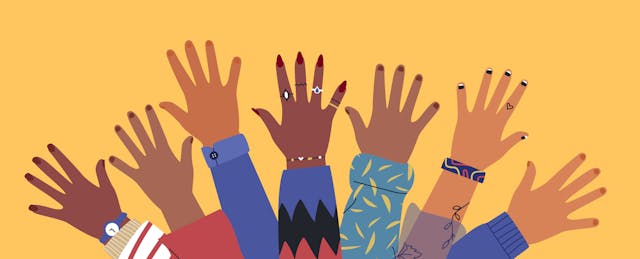When I entered the world of education, it became painfully clear that I was part of a system built on the tenets of white supremacy. As a Black immigrant woman, I quickly discovered that the expectations for being an educator in the charter school world rested heavily on my evolution into a culturally neutral professional.
To this day, I remain triggered by the word “professionalism,” a term so loaded with a Eurocentric, colonial mindset that I cringe every time it is uttered. Yet, during my first year in the classroom, I remember the explicit guidelines about how to look, sound, and behave while in the school space. The direct instructions to not speak informally (read: no AAVE or non-American dialects) to students. No headwraps unless required by an aligned religious affiliation. No large hoop earrings or unreasonably long nails.
The list asserted that these expectations were not for the young, white teachers imported from majority-white spaces. These expectations were for educators who looked like me.
These guidelines also reflected how the arbiters of our school systems viewed our students. For the sake of "professionalism", I worked hard to meet these expectations: short nails painted in muted colors, quarter-sized earrings, and a neutral accent stripped of any cultural markers. In school buildings, I was a teacher with high expectations who held the line. I made sure my students’ shirts were always tucked in, corrected the use of non-academic language, and ensured that they entered and exited all rooms in straight and silent lines. I was considered an exemplar.
In reality, I was an enforcer of systems of oppression that are prevalent in white-centered spaces. Daily, I felt like an agent of dehumanization as I upheld structures that erased the most beautiful aspects of my students’ authentic identities—students who looked like me.
So, why did I stay?
In early spring last year, at the start of what we now call “unprecedented times,” a new leader took the helm of the school. Dumar Paden, a Black man born and raised in Crown Heights, the same community where he now serves as principal. Dumar created a space where the cultural markers I once hid were now an integral part of our school community. It was his assertion that if he could not be authentic in his leadership, then neither could the people he led.
After six years in my role as Academic Dean of Achievement First, it is clear that the ultimate secret to creating real, cultural change was to be myself. There was no secret code. I just needed to be me.
Creating a Model for Cultural Authenticity
There was a palpable shift in our school when Dumar became principal. Our teachers began to speak up and out with enthusiasm about racist policies that stifled our school’s culture for years. Spaces opened for students to share, advocate, and connect without the heavy hand of “professionalism” hovering over them. Slowly but surely, staff and students alike began to let their guard down.
For me, it meant I could finally exhale. I no longer felt the need to lower my voice when asking a student, “yo, you good?” My principal unabashedly got in front of our staff and vowed to “keep it a stack” at every Friday staff meeting. Dabs replaced lukewarm handshakes between colleagues, and all was right with the world.
The freedom to embrace my cultural authenticity meant I could show my students that not all professionals come packaged in neatly pressed pantsuits and straightened hair. My 4c curls and extravagant acrylics were the new models for professionalism. I became a symbol for what our school could be, and proof that what was once deemed necessary for our students to attain educational achievement was problematic from every angle.
Growing Beyond the System
Dumar’s impact as a leader has been crucial to the design of our school culture and the development of leaders like me.
By no means do I assume making cultural authenticity the foundation of a school environment will solve all the problems of charter school systems. This work is complicated, and many of these longstanding issues require systemic change.
However, I do believe it can move charter schools towards equitable and responsive education for all. Showing up as an authentic leader ignited my fire, a fire that dimmed when I assimilated into a culture that valued whiteness more than my authenticity. As a result, there have been genuine and meaningful changes to the values and systems that define our school, changes that not only inspired me but empowered our students and teachers to bring the best versions of themselves into our community.
My power to enact change felt limited before. Now, the possibilities are endless.


